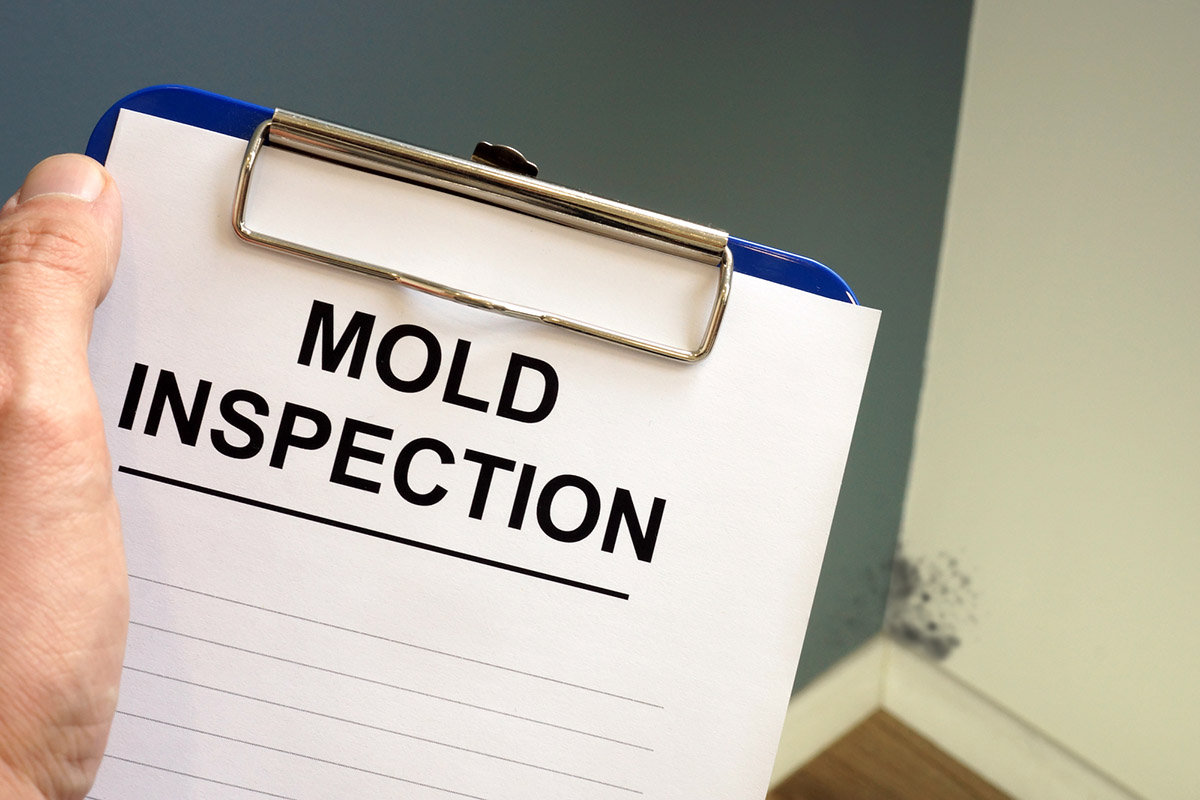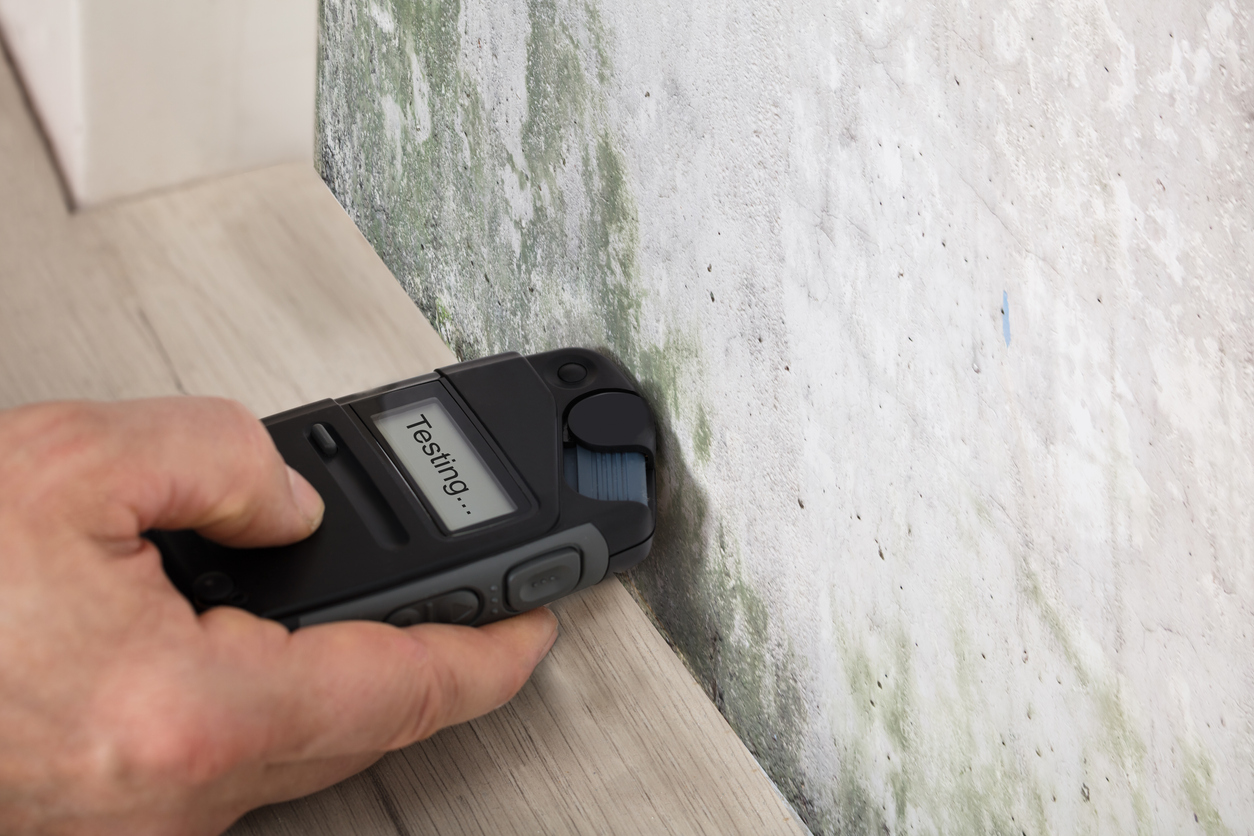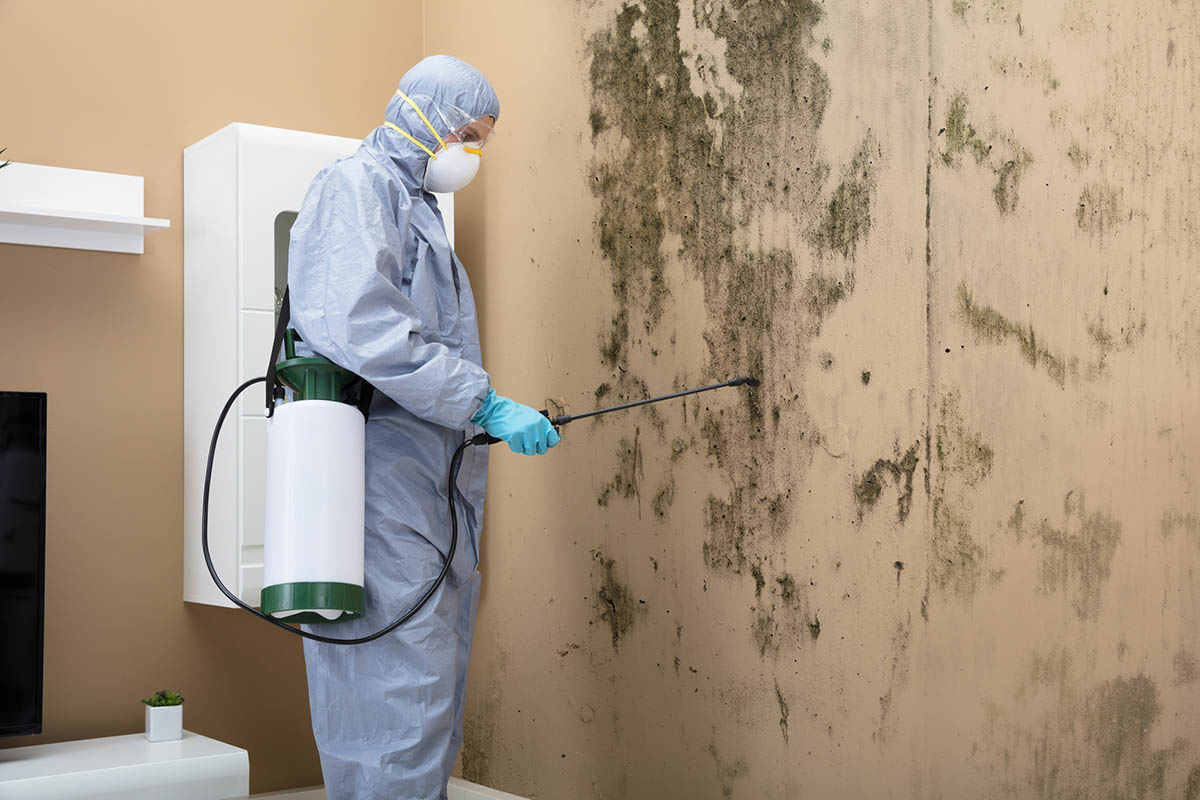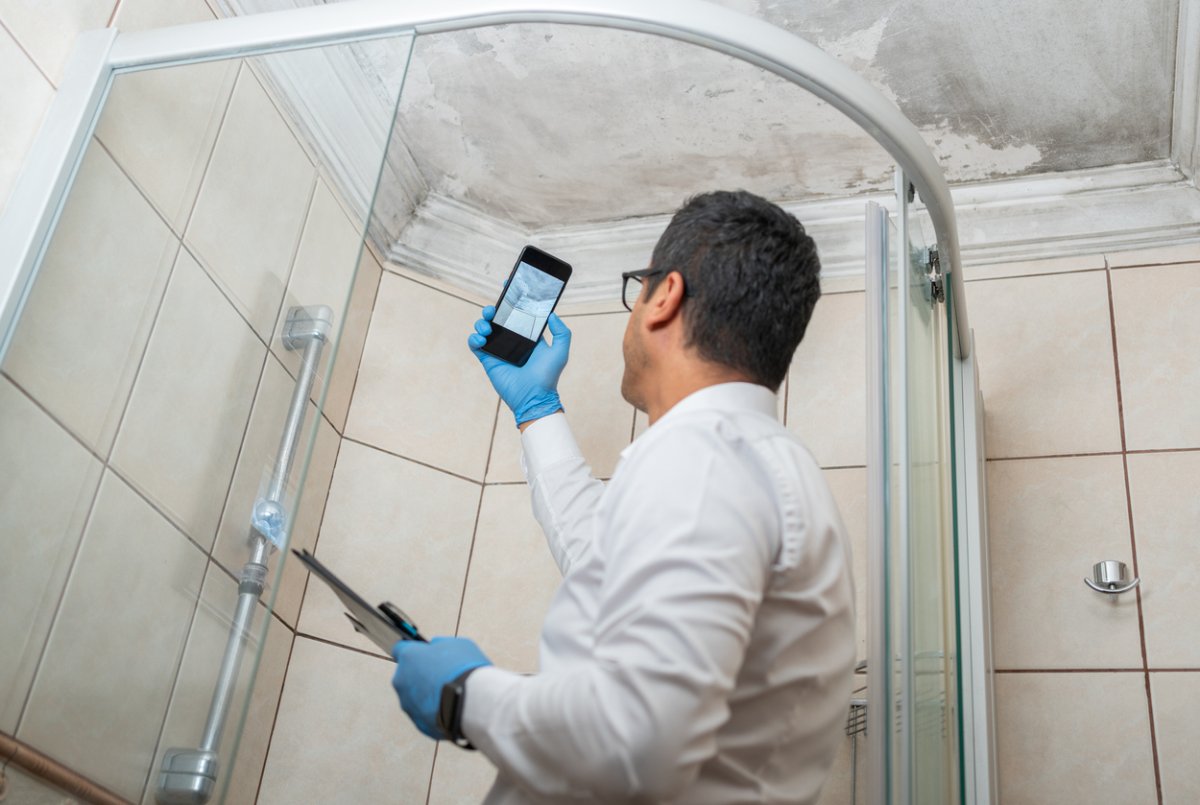We may earn revenue from the products available on this page and participate in affiliate programs. Learn More ›
What You Need to Know
- A professional mold remediation company can inspect a home for mold and determine the appropriate treatment.
- Mold is caused by moisture and can often be hidden behind walls or tiles, making mold inspection necessary to pinpoint its location.
- Left untreated, mold can spread and cause health-related issues to residents of a home.
Editor’s Note: If you are experiencing the symptoms of mold exposure, which includes coughing, sneezing, congestion, and shortness of breath per the CDC, it’s best to consult a medical professional.
Q: There’s a weird smell in my house that I think might be mold. I don’t know who to call for mold inspection—is it a plumber or some other type of contractor? And can I get a mold inspection for free, or will I have to pay?
A: The suspected presence of mold, whether it’s visible or not, can be worrisome when it’s encountered in the home. However, a mold inspection can allay these fears and help determine a plan of action. Whether you need to know how to get rid of black mold or just experienced major leaking or flooding and want to ensure no mold has formed, the following steps can help ensure a home is safe and free from major mold issues. Read on to learn who to call for mold inspection and more helpful information about mold.
You can hire a mold inspection and remediation company to inspect your home.
The first call to make when a mold problem is suspected in a home is a mold inspection and remediation company. These professionals have seen it all and will have both the experience and the equipment to inspect a home for mold. Mold inspection services are done both on single rooms and entire homes, depending on what is needed. Mold inspection services can be particularly beneficial if there has been a water or flooding issue, as mold could be forming where it’s not immediately visible. Mold inspections can cost anywhere from $300 to $500 and can take 2 to 6 hours to complete. Testing can cost an additional $200 to $350. The inspector may also perform a basic mold air test. These tests will determine if any remediation services are needed.
If mold is visible, a mold inspection isn’t necessary.
The most dangerous mold is the type that is hidden in plain sight. If you smell mold but can’t see it, that’s likely a sign that mold is growing underneath or behind surfaces in your home. These are the instances where a professional mold inspection is warranted.
Visible mold, although sometimes alarming, means a professional mold inspection isn’t necessary since treatment for mold is the same, regardless of what type it is. In most cases, visible mold can be treated with DIY solutions, depending on the surface. If the visible mold is gone but a moldy smell persists, there might still be some hidden mold.
Some companies may offer free mold inspections, but there’s a catch.
Wondering if there’s a method for how to get a free mold inspection? Customers will want to be wary of professionals who advertise or offer free mold inspections, since they likely have a financial incentive to find issues in a home that only they can fix. Because a level of mold is present in every home, these companies won’t be outright lying if they claim to discover mold in the air or on surfaces. However, no current thresholds exist that determine if a concentration of mold is hazardous, so if you don’t smell mold in the home, it’s likely not an issue that needs to be addressed. A health department mold inspection may be the best bet for a fair, unbiased report of mold in a home. There are also mold inspection companies that don’t perform remediation work, which minimizes their financial incentive to find mold in a home.

Mold is a fungal growth that forms on damp or decaying natural matter.
Sometimes referred to as mildew, mold is generally the result of excess moisture. Indoor mold spores float through the air and reproduce once they land on a favorable surface that allows them to grow and form new mold colonies. Mold feeds on organic or decaying material, so it’s common to find it on drywall or wood.
Although some molds can produce toxins, molds themselves are not poisonous or toxic. Mold inside the home can still pose a health risk, however, for people with allergies, respiratory diseases or infections, or asthma. And although some level of mold will always be present and mold cannot completely be removed from the home, the best way to prevent or control the growth of mold is to eliminate sources of moisture.
Exposure to mold can cause a variety of health problems.
Congestion, wheezing, and red or puffy eyes are just some of the symptoms that exposure to mold can cause in those who are sensitive to it. Workers who have direct and extended exposure to large amounts of mold are likely to see more severe reactions such as fever and shortness of breath. Some recent studies even linked early exposure to mold to the development of childhood asthma, especially among kids who are genetically susceptible to respiratory conditions.
Mold testing can be performed on air and surface samples.
Most mold testing requires taking samples of either the air or surfaces in a home to figure out what type of mold is present or whether it’s likely to spread and cause more damage. Air samples use a spore trap, which has a sticky surface on a strip to capture the spores that travel through the air. The strip is then sent to a laboratory for analysis and results.

Surface samples can be tested using one of three methods: bulk, swab, or tape. In a bulk sample, a piece of the surface is removed and sent to a lab for testing. For a swab sample, the area in question is swabbed with a sterile material, and the swab is then sent to a mold testing laboratory. With tape samples, a piece of tape is pressed against a surface that has mold present, then lifted and sent to a lab for results.
It’s important to note that determining the exact strain is not important when treating mold, as all molds are tackled in the same manner. Customers will want to be wary of companies that attempt to make their services look more valuable by claiming to treat various molds in specific ways.
Mold inspection costs an average of $650.
Mold inspections cost about $650, regardless of whether it is a black mold inspection or an apartment mold inspection. A mold inspection is typically the best first step in determining how extensive a mold problem is and whether major remediation needs to be done to make the space safe again.
For those who’d like to sidestep the cost of a professional inspection and try to perform a home mold inspection themselves, the best mold test kits range in price from $30 to $90 and can be purchased easily online. DIY mold testing can be useful and more cost-effective if the suspected mold is contained to certain areas, like a bathroom or under the kitchen sink. However, it’s important to remember that the results can vary and in some cases can even be inaccurate if the tested material comes in contact with other airborne contaminants. Customers will want to closely follow directions to ensure accurate results.
Professionals should treat large or widespread areas of mold.
One small area of mold can be treated with DIY methods, but any widespread areas that have mold should be handled by a professional. The EPA recommends professional mold inspection and treatment for patches of mold larger than 10 square feet. Homes that have experienced major water leaks or flooding will most likely need the help of a remediation specialist who can not only find where the mold is growing but also remove it and put measures in place to prevent it from coming back. The best mold removal companies will also have the required equipment, such as industrial fans, to help with airing out the space. Plus, if they have to remove drywall or go through walls, they’ll be able to repair the areas afterward.
The lines can be blurry when it comes to responsibility for mold treatment in a rented property.
Unfortunately, building codes and other ordinances don’t clearly define who is responsible for treating mold in rental properties. However, renters can check the rules and regulations concerning mold by looking at their state’s department of environmental protection or their state department of public health’s website. If legislation is in place, renters can look to those guidelines to figure out next steps. However, even if the state doesn’t have current legislation regarding mold, state law may require the landlord to fix a serious mold problem or the tenant may be able to withhold rent if the space is no longer considered safe or livable.
On the flip side, if any evidence of mold is a result of tenant behavior, such as failing to maintain cleanliness or creating high humidity, landlords won’t be on the hook for repairs or scheduling a free mold inspection for renters. In fact, some leases even include clauses that relieve landlords from liability from mold growth, so it’s wise to read the fine print when signing a lease.
Mold can be controlled and prevented.
The good news about mold is that you can take specific measures to prevent it or treat it if it presents itself in the home. The best way to keep mold from spreading inside a house is to keep humidity levels low, ideally around 50 percent. One of the best hygrometers can display the air’s current humidity levels. Air conditioners and dehumidifiers also go a long way in ensuring the air in the home is less humid. If prevention methods still can’t keep mold at bay, you can certainly call professional mold inspection and testing services.

Air purifiers can help prevent the spread of mold, but they won’t treat mold on surfaces.
For those concerned about mold in the home, air purifiers provide one way to help reduce the spread of mold spores in the air. However, these machines can only keep those spores from landing on surfaces where they can grow and become a bigger issue—they don’t treat any active mold that is already growing on windowsills or underneath the kitchen sink. Once the space has been tested and treated for mold, an air purifier with a HEPA filter will be the best bet for capturing mold particles and preventing them from proliferating.
FAQs
Do you still have more questions about mold in the home? Check out these answers to some of the most common queries.
You can hire a mold inspection or remediation company, or you can use a DIY test kit for small areas of suspected mold.
Congestion, wheezing, and red or puffy eyes are just some of the symptoms that exposure to mold can cause in those who are sensitive to it. Workers who have direct and extended exposure to large amounts of mold are likely to see more severe reactions, such as fever and shortness of breath.
Symptoms can appear 2 to 9 hours after exposure and last for 1 to 3 days.
Air purifiers provide one way to help reduce the spread of mold spores in the air. However, they can only clean up airborne spores—they don’t treat any active mold already growing on surfaces.
The EPA recommends hiring a professional for mold remediation for areas of mold larger than 10 square feet.
Black mold is the most common toxic mold that comes to mind, and while its name suggests a black color, it can also be blue, gray, or green. Black mold looks like an irregular stain.
It’s not necessarily possible to kill mold instantly, but vinegar is one of the more effective mold-killing solutions as it kills the surface layer and the underlying membrane.
You may be able to sue your landlord for mold if you have any losses relating to mold, such as a health problem or property damage.


